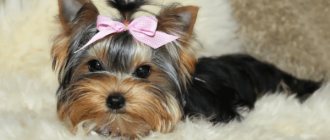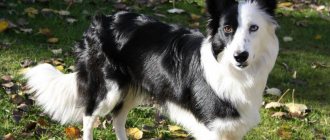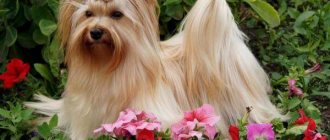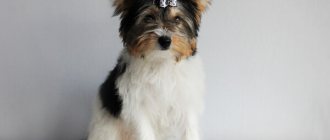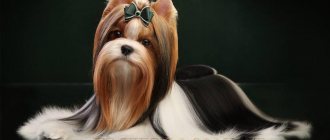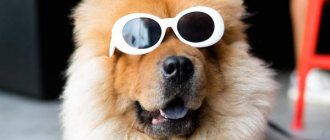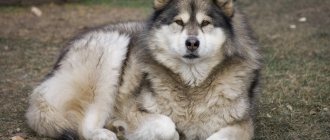The Yorkshire Terrier is one of the dog breeds popular all over the world.
People unfamiliar with this breed perceive them as living toys, but in fact, the Yorkie is a real terrier. And like all its larger relatives, it is distinguished by its mobility and energy.
What is the secret of the popularity of these dogs and is it only their cute appearance that is the reason that people living both in cities and in rural areas willingly adopt them? Let's try to figure this out. We will also show photos of these wonderful pets.
Description
Yorkshire Terriers (Yorks) are small dogs with tenacious characters. This is one of the most popular breeds in the world. Yorkies are generally faithful and loyal. Despite their small size, the animals make excellent watchdogs. At heart, they are wonderful companions who love to be close to their loved ones.
Goldust
A rather rare variety of Yorkshire terriers is the Goldust, or “white gold Biewer”, or “gold dust” . The originality and showiness of dogs of this breed is given by the color of their coat, which varies from white and gold to various shades of gold. It is quite difficult to purchase a pet of this type of Yorkie, because in order to obtain such offspring it is necessary that both parents have this color.
A breakthrough in the world of dog handlers and breeders is the Blue Diamond Goldust York breed, the representatives of which differ from other types of Yorkshire terriers by the sky-blue iris of their eyes.
Appearance
— Advertising —
The Yorkshire Terrier is a tiny dog. The normal weight of an adult is 1.81-3.17 kilograms. These are not tall animals: they grow up to 23 centimeters. Despite its tiny size, the dog loves speed.
The American Kennel Club prescribes the following parameters for the breed: a smooth-haired toy terrier, with a compact and well-proportioned body. The dog's high head and self-confidence gives it an energetic and proud appearance.
The head is miniature, flat on top. The skull is not convex, the muzzle is not too elongated. Scissor bite.
— Advertising —
The nose is black and wet.
The eyes are medium in size, not protruding. They are dark in color and intelligent. The rims of the eyes are dark.
The ears are small, V-shaped, stand vertically, and are located not far from each other.
The body is well built and compact. The back is short and level.
The front and rear legs are straight. When viewed from behind, the knees are slightly bent. Paws are round, with black nails. The tail is docked.
The quality, texture and quantity of wool are of great importance. The hairs are silky and thin. The body coat is moderately long and straight.
Several colors of the breed are recognized:
- Black and gold.
- Black and beige.
- Blue and beige.
- Blue and gold.
- Silver or ash and beige.
- A mixture of black, white and brown colors.
Chocolate
Long-haired type, which got its name due to its unusual color. This baby's face is medium in size and has walnut-colored eyes. The shade of a chocolate Yorkie can range from milk chocolate to dark chocolate. All this gives it unprecedented refined outlines and charm.
Pros and cons of a dog
Characteristics of advantages:
- Yorkies are loyal and make excellent family pets.
- They hardly need any exercise.
- Yorkshire Terriers are adaptable and can live in an apartment or house.
- They are usually long-lived individuals.
- Yorkies are smart dogs that learn new tricks quickly.
- The pet does not smell or stink.
Characteristics of minuses:
- The disadvantage is that some individuals may bark constantly.
- Dogs are not suitable for families with small children.
- Their coat requires special care and needs daily brushing.
- Yorkshire Terriers are predisposed to some serious health problems.
- Pets shed.
- This is an allergenic breed.
How to feed?
The Yorkshire Terrier needs high-quality food.
NOTE!
If the choice is made in favor of branded food, it must be at least premium (for mini and micro - not lower than super-premium) and suitable for small breed dogs.
If the dog eats natural food, then feeding should be balanced.
History of the breed
The history of this magnificent species is quite interesting. Several breeds were combined to develop the Yorkshire Terrier. The dog was first known as the Hairy Scotch Terrier and then as the Toy Terrier. Finally, in 1874, it received its current official name - Yorkshire Terrier.
In the mid-1800s, England was at the height of the Industrial Revolution. Many miners and workers from Scotland went there in search of work. They brought with them small terrier dogs, which were then called "broken Scottish terriers."
Many people know that Yorkies were used to kill rats and vermin that hide in small places. Dogs were placed in mines and mill buildings to help workers control the rodent population. However, it later became clear that the Yorkshire Terrier has great advantages and skills.
The pets were skillful, so they helped catch prey. People took Yorkies in their pockets when going to hunt foxes, badgers and other small and medium-sized wild animals. When animals become trapped, they can become aggressive. The Yorkshire Terrier was known for its bravery and courage. It seemed that the dogs had truly found their calling, but the breed became so popular that people began to take pets into their homes.
It was during the Victorian era that the animal evolved from a hunting species to a companion dog.
The royal and upper classes in England loved the breed for its unique appearance and small size. Because the dog became so popular in Britain, its popularity later spread to America.
Data states that the breed received the official name Yorkshire Terrier in 1874.
In 1872, the species gradually began to appear in America. By 1878, the American Kennel Club officially registered the animal.
The most famous representative of the breed is a dog named Smokey. He served with the 5th Airborne Division in the Pacific Theater during World War II. The dog became part of the unit, flying over 150 air raids and 12 naval missions. He was very courageous and resilient, and also survived a dangerous typhoon in Okinawa.
Today, the Yorkshire Terrier is one of the most popular small breeds in many countries.
Peculiarities
One of the main advantages of Yorkshire Terriers is their long, shiny coat, but people are also attracted to the dog's character. Yorkie is a dog - a companion, a devoted friend and just an incredibly affectionate dog. However, it is still a terrier, so it can be quite menacing and is capable of barking at strangers or becoming wary when hearing strange sounds.
To avoid complaints from neighbors, attention should be paid to eliminating unwanted spontaneous barking from your dog.
Yorkshire Terriers consider themselves guards and protectors of their owners. Therefore, they often try to get involved in a fight if, in their opinion, the owner is in danger. It is believed that Yorkies are hunting dogs and some hunters, seeing the advantage in the compact size and keen sense of smell of these dogs, purchase and train them specifically for hunting.
A special feature of Yorkies related to their teeth deserves special attention. It often happens that milk teeth in dogs do not fall out and molars grow in the second row, so it is important to monitor the process of changing teeth and, if necessary, remove milk teeth in a veterinary clinic under anesthesia to avoid the formation of malocclusion.
Yorkshire terriers are divided into several categories: show dogs, breeding dogs and just pets. As a rule, the latter show some deviations from the breed standard: weight, size or color. Yorkies are distinguished by a fairly high life expectancy - about 16 years.
Maintenance and care
Care and maintenance of a Yorkie includes 7 main elements:
- Create a resting place for your pet. There he can spend time when you are away from home and sleeping at night. Sometimes your pet snores, so he should have a separate place to sleep.
- Give your animal a balanced diet and plenty of water.
- Groom your Yorkie regularly. Bathe your pet, brush its teeth, groom its coat, trim its nails.
- Bathing procedures occupy a central place in animal care. Bathe your dog about once every 3 weeks. Choose a special shampoo or natural soap. These products will help solve and prevent problems (such as itchy or dry skin) and keep the skin and coat healthy and hydrated. Shampoo and soap with a pH between 6.5 and 7.5 are ideal. If your pet is wet after the procedures, do not take him outside!
- Cleaning. Short coats should be brushed two to three times a week, while long coats should be brushed every day. It is extremely important to use brushes that are designed for small breeds.
- Nails should be trimmed approximately every 6 weeks. You can do it at home or at a groomer.
- Dental care. The breed is prone to tooth decay. Therefore, part of proper Yorkie care is ensuring good oral hygiene. This includes brushing your teeth daily with a toothbrush or toothpaste.
- Exercise your pet every day.
Providing daily exercise plays a big role in your pet's health, both now and in the future. It is good for the heart, lungs and other major organs. Exercise helps regulate your metabolism, stimulate your appetite, and reduce your likelihood of developing a wide range of diseases.
Getting outside helps your puppy or dog release pent-up energy. Otherwise, she may be directed toward barking or chewing on objects. You should walk 2 times a day. Buy a harness for walking.
- Do certain care routines at varying intervals, but regularly. This includes haircuts, vaccinations, grooming, flea and tick protection, deworming and more.
Also protect paws and nose when necessary.
Paws are a part of the body that many owners overlook. But there are many dangerous things that can happen. These include burns from hot surfaces, snow melt in winter (when snow melts and then freezes between the toes, cracking of the skin occurs), lacerations, reactions to contact with allergens and/or irritants.
Nose protection. Problems with noses can begin in late fall and throughout the winter. During this time, your nose may become dry and cracked. To eliminate the above-mentioned things, rub in special oils or balms.
Answers to questions - what you need to know
Before buying a puppy, responsible owners try to find out everything about the breed, but over time, practical questions arise, the solution of which will require patience and skill.
How to toilet train at home
Diaper training begins immediately after the baby moves to a new home. For a comfortable and safe life for a puppy, you need to fence off a small space through which he can move without the risk of injury. A waterproof diaper is laid in the enclosure and the baby is carried on it every time after sleep and 15 minutes after eating.
If the Yorkie makes a puddle in the wrong place, then it is blotted with a diaper, which is taken to the enclosure. The stain is washed away and all odors are destroyed so that the dog does not return to this place. After the Yorkie gets used to the diaper, he is trained to use the tray. The used diaper is placed in the tray for several days and then removed. At first you will have to watch the dog and take it to the toilet.
How to toilet train outdoors
This process requires patience and persistence. Yorkies are taken outside every time after sleep and meals. The dog is not taken home until it has done all its work. York is made to understand that he must go to the toilet first and then play games. After several weeks of repetition, the baby will understand what the owner wants.
How to trim your Yorkie's nails
Before the procedure, you need to purchase a nail clipper of a suitable size, cotton swabs and dry potassium permanganate to treat the living part of the claw. This is a clearly visible blood vessel. If you touch it, the dog will be in great pain and will refuse to continue the procedure.
Therefore, it is recommended to cut the claw from the very tip. If necessary, the incision is repeated. After this, the edges of the cut are lightly rubbed with a file. While grooming, you need to talk to your Yorkie all the time in a gentle voice and reward him with a treat at the end. It is best to carry out the procedure when the dog is as relaxed as possible.
Dog character
Yorkies are true companions, but each dog has its own unique characteristics and quirks. The American rating states that the breed ranks 17th out of 90 in intelligence. Therefore, a pet can learn a lot if the owner takes the time.
Consider the general traits of temperament:
- High intelligence.
- Activity
- Independence.
- Energy – most of the individuals are ready to train and play at any time.
Yorkies' behavior towards people outside the home varies greatly depending on the individual. Some may bark at every stranger, while others greet a person with “kisses.”
The first 3 months of a dog's life greatly influence the dog's personality, temperament and behavior.
Socialization is the key to developing a dog's personality and teaching him about the world around him. Yorkies should grow up with normal household noises. Therefore, show your pet everything that awaits him throughout his life: from the TV and washing machine to the doorbell.
Gradually accustom your pet to human voices and touches. There is a huge difference between a dog that lives in a cage and a pet that is raised in human arms.
Hold, bathe, groom, cuddle, play for the first 3 months. This will create a puppy that will be comfortable with people and the environment in the future.
The owner must immediately show that he is a leader. This can be achieved in different ways, for example, when you take your dog for walks, you control the walking speed.
Dogs get along well with other pets such as cats and other dog breeds.
Russian salon
The newest modification, produced in Russia. The coat color of dogs is usually reddish, but there are cases when there are babies with white and black spots on their paws. The thick coat has an undercoat, but in winter the puppy still needs clothes and shoes.
What type of Yorkie do you like best?
Nutrition
Feeding your pet a balanced and nutritious diet is one of the most important care tasks. Every morsel of food you offer will be either harmful or beneficial. A dog's diet affects its health in a variety of ways. Food can cause both allergic reactions and affect the condition of the heart. But of course, it plays a big role in the dog’s life expectancy.
Due to their small build, the Yorkie needs fewer calories compared to other breeds. However, depending on age and activity level, calorie requirements vary. According to research, active individuals need about 200 calories per day. Inactive animals consume no more than 150 calories per day.
Plan a feeding schedule based on your dog's calories and nutritional needs.
Yorkies have a thin stomach and their digestive system is often unable to process food quickly. If your dog overeats or doesn't take a break between meals and exercise, he may suffer from gastrointestinal problems.
You should give your pet small portions and provide at least an hour break between eating and playing. Divide your daily caloric intake into several small meals. Feed puppies four times a day, and adult dogs 2-3 times a day.
Determining your serving size requires 3 steps:
- Find out how much your pet weighs. Don't try to guess. Weigh your dog using a reliable scale (such as a kitchen scale). Or ask your veterinarian to weigh you.
- If you are giving your pet store-bought food, read the recommended serving size on the label. Portions are based on a standard range of what a puppy or adult dog's body needs.
- When you prepare food, use a dry measuring cup or kitchen scale.
Dehydration is the leading cause of life-threatening disease in small breeds. Make sure your pet drinks about a cup of water daily. Water is good for skin health and digestion in Yorkshire Terriers.
If your pet refuses to eat, you must find out the reason and eliminate it immediately.
Feed
For small breeds like Yorkies, dry food is the best choice. This breed is prone to dental problems, so it is preferred.
Choose food that is healthy and enriched with nutrients. It is not necessary to provide premium food. Consult your veterinarian about your dog's nutritional needs. And then check whether her current diet contains all the necessary components.
There are such nutrients:
- Proteins: They provide energy and strength. Your Yorkie's diet should contain 30-40% protein from meat and grain products.
- Fats. Give your Yorkshire Terrier the right amount of healthy fat to keep his coat silky and shiny. Any food for Yorkies should contain Omega-3 and Omega-6 fatty acids. Too much can lead to obesity and pancreatitis.
- Vitamins and minerals. They are essential to keeping your dog healthy. Fruits and vegetables are the best sources of these nutrients.
- Carbohydrates. They are of limited benefit for Yorkies with sensitive stomachs. Mild sources of carbohydrates such as oatmeal, sweet potatoes and barley are good for your dog. However, try to avoid corn and complex carbohydrates.
Homemade food is also suitable for dogs if you have time to cook. Commercial dog food with different tastes and smells, colors and toppings often leads to digestive problems. If you cook your own food, you can prevent gastrointestinal diseases.
Use lean meats, vegetables, grains, eggs, milk, cheese and regular potatoes when preparing dog food at home. Make sure you're eating the right calorie to nutrient ratio.
When feeding your animal, pay attention to the following:
- Avoid products with too many preservatives, colors and flavors. Check the ingredient list before purchasing food. Make a list of harmful substances and foods for this breed.
- Pay attention to your Yorkshire Terrier's digestive system and plan meals accordingly. Include more protein in your puppy's food if he is hypoglycemic. Puppies under 5 months of age, pregnant dogs, and adult dogs with liver disease often have abnormally low sugar levels.
- Yorkies should not be given table scraps.
- Use only metal bowls to feed individuals.
- Always choose an easy-to-digest pet food to prevent your dog from having digestive problems.
Purpose and characteristics
Expert opinion
Anna Abramenko
An avid dog lover. Experience in veterinary medicine since 2009.
Ask a Question
Pets are prone to injury and are sensitive to pain, so careful attention is especially necessary in homes where Yorkshire terriers and small children live at the same time.
The dogs are distinguished by their confident behavior and cheerfulness. Guard instincts are developed - Yorkies become wary and growl at suspicious noises, and bark loudly at guests. When walking, terriers show hunting tendencies - they often chase large insects, frogs, lizards, cats, and birds.
Kinds
Dog breeders have bred several varieties of Yorkies.
Mini
Most people are very familiar with Yorkshire Terriers. However, not everyone knows about mini (dwarf) Yorkies. Basically, they are the same dog and breed in every way. The only difference is the size and weight of about 2 kilograms.
If you decide to acquire such a friend, pay attention to the following:
- Pets need to be constantly monitored. Due to their small size, they can easily fall off a chair, sofa or other furniture.
- If there are small children in the family, this dog is not the best choice. Kids may not calculate their strength and torture such a pet.
- You should not take on breeding a Mini Yorkie unless you are an expert.
- They live shorter lives than their brothers.
- This is a hypoallergenic dog.
Beaver
This type of breed was first registered by German breeders in the 80s.
The main difference between the Biewer Yorkshire Terrier and the standard one is the color of its coat. Individuals have a black-and-white or gray-white color, with golden veins on the muzzle.
A big plus of this species is the health of the skeletal system. It has been proven that such animals have a fairly strong musculoskeletal system.
Biro-Yorks and Shoko-Yorks
Biro Yorkies also differ in the color of their coat. Individuals do not have black hairs. The main color of the breed is chocolate, with a shade called golden.
There is a slight difference in size: Biro-Yorks are slightly larger than the standard.
More recently, another subtype of the breed was created, namely the Choco-Yorkie. Their body color is exclusively chocolate.
Baby
Baby Yorkie is a species similar to an ordinary pet. The main difference between the subspecies is the non-standard muzzle.
The features are as follows:
- The head is round.
- The muzzle is shorter than that of traditional animals.
- The ears are located below the level of the forehead.
- The eyes are large and protruding.
Because of these characteristics, his face appears cute and resembles the facial expression of a baby doll. Hence the name - baby face.
Who is the Yorkshire Terrier suitable for?
The exceptional popularity of the breed is understandable: the Yorkie is not just a beautiful dog, but a true friend, capable of cooperation and understanding, not without a sense of humor and self-esteem. But before you run to get a puppy, weigh your options.
The Yorkshire Terrier is not a suitable breed for business people who are away from home for a long time; they cannot stand prolonged loneliness. Families with children under 8-10 years old should not have them either. The Yorkie is a good companion for mature adults with a strong financial position who are willing to devote enough time and attention to the dog. He will share long walks in the park with his owner, and in the house he will create a special atmosphere of comfort and fun.
Why do you love Yorkshires? Share your pet's features in the comments!
If this article was helpful, please support the author HERE. You can also purchase a fictional story about the work of veterinarians “Dachshund of Fate” using the link.
Girl
Sexual dimorphism in individuals is weakly expressed. The differences in weight and height are very minor.
Yorkie lovers believe that females are more affectionate than males. This is a wrong opinion, since both sexes are equally affectionate.
If a female Yorkie is spayed, it can cause her hormonal changes and affect her mood. Bitches may want to spend time alone and have less fun.
Yorkshire Terriers, as a rule, require a lot of attention, love and care from their owner. Female Yorkies are more demanding than males.
There is a common belief that girls are more obedient and submissive. This is not an entirely correct statement. Whether it is people or dogs, the behavior of an individual person or dog depends on upbringing and the specific personality.
Mini
Mini Yorkies are distinguished from the standard by their miniature size - these dogs weigh approximately 2 kg. They also have a calmer and more affectionate character, cleanliness, and do not require so much attention. Among representatives of mini Yorkshire terriers, problems such as malocclusion and open fontanel are common.
If you decide to purchase a mini or super mini Yorkie, you must contact only trusted nurseries!
Since unscrupulous breeders can sell sick animals under their guise or deliberately underfeed healthy ones in order to reduce their weight and size.
Boy
Due to weak sexual dimorphism, a boy can be distinguished solely by his genitals.
Both sexes require a lot of attention from their owners. Yorkie men are less capricious than women. This is especially noticeable in cases where castration has been performed.
Sometimes boys try to establish themselves as the leader of the pack. This must be prevented immediately. You must become a leader for your pet from a very early age.
Yorkie character and intelligence
Terriers are great companions that are ready to go on any trip. Despite their independent nature, they adapt well to urban living conditions.
Reviews about the character of Yorkshire dogs show that the dogs are good-natured and cheerful. Communication with the owner is directly related to jumping, running and games. When walking with your pet, you should not be surprised at their cocky character; the Yorkshire Terrier can chase cats and other dogs, regardless of their size.
According to its psychology, the Yorkshire Terrier is a protector who is ready to stand up for the owner even while in his hands. In order to prevent damage to property in the apartment, the dog must be given the opportunity to throw out all its energy in games with the owner and on the street. Pets especially enjoy walks in unfamiliar areas.
Castration should be carried out only in cases where the terrier will not be used to reproduce offspring. Additionally, this will allow you to get rid of cases of inappropriate behavior during moments of excitement.
Nicknames
For boy
Popular names for male dogs:
- Aidan.
- Archie.
- Billy.
- Caden.
- Connor.
- Dylan.
- Ethan.
- Evan.
- Layam.
- Jack.
- Jackson.
- Small.
- Henry.
- Leo.
- Lucas.
- Logan.
- Matty.
- Nid.
- Noah.
- Ollie.
- Owen.
- Sammy.
For girl
Popular nicknames for girls:
- Abi.
- Aria.
- Bella.
- Brandy.
- Boni.
- Brookie.
- Callie.
- Chloe.
- Clara.
- Emma.
- Flory.
- Gracie.
- Anna.
- Izzy.
- Laura.
- Lexi.
- Liv.
- Lottie.
- Mia.
- Riley.
- Sarah.
- Sophie.
- Zoe.
How many years does a dog live?
Yorkshire Terriers can be called long-livers. The average life expectancy is 13-15 years, and some individuals live up to 16-18. The exception is the Mini Yorkie, a “pocket” breed that weighs less than 1.5-1.7 kg. They suffer from dwarfism, often have genetic mutations and hereditary diseases, so they live no more than 7-9 years even with good care.
In adulthood, children's illnesses become more acute, so prolonging their lives and getting rid of unpleasant symptoms will require a lot of time, effort and money.
Breeding
Only healthy, purebred individuals are allowed to mate.
A girl's first heat begins at the age of 8-10 months. It is divided into two periods. During the first, dark, round droplets appear. During the second, they brighten. This indicates imminent ovulation. The estrus itself lasts up to 20 days.
The female is ready for her first mating at the age of 1.5 to 2 years. Mating is not allowed if the girl is over 8 years old.
Consider the weight of the animal. It should be 2-3 kilograms. With less weight, the bitch may not bear offspring.
Preparing individuals for breeding:
- Choose a couple in advance and introduce them.
- Give your pets all necessary vaccinations no later than a month before estrus.
- Get rid of worms from future parents.
- A week before breeding, wash and cut the dogs.
Pregnancy lasts 58-64 days. 2-3 weeks after conception, the mother begins to show symptoms of pregnancy: her nipples swell, her tummy becomes round, her appetite sometimes disappears, she becomes lethargic and sleepy.
The normal basal temperature of a bitch is 38.5°C. Immediately before the babies are born, the girl’s basal temperature will drop by 1-2 degrees. It will be 37-37.5°C.
Childbirth does not last long. If your bitch is giving birth for the first time, it is better to enlist the help of a veterinarian.
3-4 puppies are born at a time.
Photos of the puppies are presented below.
Mating
Yorkie breeding is not always breeding due to their large population throughout the world. One way or another, the male and female must meet the standards, be vaccinated and examined for pathology by a veterinarian .
- Puberty occurs at 8-9 months. At this time, males begin to breed, and girls go into heat.
- You can only breed at the 20th month of life, when the female goes into her third heat. The readiness of a bitch can be determined by several signs: the discharge becomes lighter, the loop swells, the girl spreads her paws wide and throws back her tail.
- For the first mating, you can invite a specialist to help your pets. The female is brought to the male's territory, where the acquaintance should take place. The dogs should be given 10-15 minutes to sniff and get used to each other. When the bitch is ready, she will let the male do the mounting.
- The act does not last long - 10 minutes, and the lock from 15 to 30. The girl must be held under the stomach, not allowed to sit down. The male is directed into the noose. Due to the difference in size, the boy may simply not be able to reach it, in which case he needs to be seated.
- Mating is repeated after 2 days.
Puppies
Newborn pets weigh about 0.7 kilograms. A puppy's appearance is slightly different from an older, mature dog. It has short, soft fur, black and brown in color. The dog's eyes will remain closed for up to 2-3 weeks. Month-old babies still have poor vision.
The appearance of a puppy in your home should occur no earlier than when it reaches 2 months of age.
How to care for a puppy?
Taking care of a two-month-old Yorkie is not that difficult. Love and attention are the basic needs of your new friend from birth.
- Puppies need a balanced, nutritious diet, which can only be provided by quality food.
- Provide your Yorkie with a diet that is tailored to their height and weight. They need to eat at least three times a day. Until the puppy reaches three months of age, there should be food in the bowl constantly. Water should also always be available.
- Your pet should chew the treats you offer with ease. Treats that are too hard can cause blockage in the trachea or other airways.
- Caring for your Yorkie includes taking care of teething. Buy a few special toys so your pet can chew on them.
- Puppies sleep a lot. A normal puppy sleeps on average 13 hours a day. Even if he sleeps 18 hours a day, this is also normal. Set up a corner for relaxation.
- You should incorporate time to care for your puppy into your daily routine. Grooming should include bathing, brushing, trimming nails, cleaning ears, and so on.
- Proper exercise on a daily basis is extremely important for your Yorkie's health. Running around the house won't be enough. Set a specific time each day when you take your puppy outside for fresh air. Give him some exercise there.
- Puppy proofing your home is very important. They are curious explorers! Make sure that there are no electrical wires or other dangerous objects within their reach.
Feeding rules, diet
On the first day your Yorkshire Terrier puppy arrives in your home, provide him with a food bowl and a drinking water bowl. This should be a place where the dog can eat quietly, otherwise the animal will pull food out of the bowl and drag pieces to a secluded corner, for example, under the table. In most cases, the place for feeding is determined in the kitchen, but this decision is entirely at the discretion of the owner.
New dog owners often make the same mistake of leaving food in their dog bowls all day. You can’t do this, after pouring food for your pet, wait about twenty minutes and remove the bowl, regardless of whether there is food left in it or not. Unlike food, clean, cool water should be available to the animal 24 hours a day. Do not teach your dog to bite, do not allow him to beg for treats during your own meal.
Starting from the first feedings, accustom your Yorkie puppy to the feeding schedule. You need to give your dog food at the same time. The number of feedings and the size of portions depends on the age and health of the pet. If a small puppy needs to be fed 5-6 times a day, then an adult dog needs 2 meals.
It is recommended to prepare the diet together with the veterinarian who is monitoring your pet. The diet must be balanced, the dog must receive all the vitamins and minerals necessary for the body. The owner himself decides which type of feeding to choose: natural or dry. Of course, it is much easier to buy ready-made food than to spend time preparing natural food. In both the first and second cases, it is unacceptable to use expired, low-quality feed.
When you take a small puppy from a nursery, be sure to ask the breeder what the baby ate before moving to a new place of residence. It is recommended not to suddenly change the usual diet; if you still want to switch your dog from dry food to natural products, this should be done gradually and very carefully to prevent stomach upset.
Education and training
It is important to start training and socializing your puppy as early as possible.
Yorkshire Terriers strive to please their owners - they enjoy praise and encouragement. These are smart dogs that learn lessons quickly.
Trained individuals excel in dog sports such as rallying. Sports and puppy obedience classes can be a great way to both exercise and bond with your pet.
It is recommended to introduce children to different people, animals and situations. Pets are generally wary of strangers. Take your puppy to the park or invite friends over at home. This will help the animals get used to new people and situations.
Dogs can bark. However, you can minimize this habit by not reacting. Dogs bark more when they learn that noise produces results. Just ignore the barking and praise your pets when they are quiet.
Train your pet to a routine. Thanks to this, the dog will know what to expect.
- Wake Time – The day goes well when your dog wakes up at the same time as you.
- Feeding Timing – Maintaining a proper feeding schedule keeps the breed happy and you a leader.
- Time for exercise.
- Walking.
- Game time.
- Quiet time.
- Bedtime – Knowing what time they should relax and retire to their bed helps them stay happy and confident.
Photo and video review
To get a complete picture of the Yorkshire Terrier breed, we suggest that you familiarize yourself with the detailed photo and video review.
To get a complete picture of the Yorkshire Terrier breed, we suggest that you familiarize yourself with the detailed photo and video review.
Diseases
With proper care and nutrition, your pet will rarely get sick. If your baby gets sick, it is better to contact a specialist.
Below are some Yorkshire Terrier diseases that you need to know about.
- Congenital portosystemic shunt. Portosystemic shunt is also known as liver bypass. This is a problem that Yorkies are genetically predisposed to. Congenital portosystemic shunts occur in slightly less than 0.2% of all purebred dogs. Defects in the development of veins cause abnormal blood flow. Some of the blood flows around the liver, not through it. Consequently, the liver cannot completely eliminate toxins. This results in stunted growth, seizures and behavioral problems. In some cases, the problem can be treated with diet and medication, while in others it requires surgery.
- Cushing's disease. Yorkshire Terriers have a high predisposition to Cushing's disease. It is caused by an overreactive adrenal gland that produces too many steroid hormones. Symptoms of Cushing's disease include excessive urination, increased appetite, decreased activity, thin skin, and hair loss. Treatment is carried out with medication, under the close supervision of a specialist.
- Heart problems. Heart failure is the leading cause of death in older Yorkshire terriers. Two conditions they are prone to are patent ductus arteriosus and mitral valve disease. Signs: the dog is breathing heavily, wheezing, choking, coughing, has shortness of breath, gets tired quickly. Dogs with these problems have a specific type of heart murmur. They can be eliminated with surgery.
- Hypoglycemia. All small dogs are prone to hypoglycemia. This condition can be fatal if not recognized and treated. To avoid a sharp drop in blood sugar levels, you need to feed small dogs more often than large breeds. This is especially true for the first few months of life. A dog with such an illness often shakes and trembles. Contact your veterinarian if you notice any of these signs in your pet.
- Legg-Calvé-Perthes disease. This is a hip problem that occurs in small breed dogs. The symptoms are caused by spontaneous degeneration of the femoral head. This is the long bone of the leg that is located in the femur area and allows for smooth rotation of their leg. The problem is treated surgically.
- Hemorrhagic gastroenteritis. This is an acute and serious illness that can lead to death. Symptoms include bloody diarrhea, vomiting, decreased appetite, lethargy, constipation and fever. Sometimes the dog just gets sick. Diagnosis by a veterinarian may require extensive testing. Treatment includes intravenous fluids, potassium, and electrolytes. In severe cases, your doctor may prescribe antibiotics.
- Other problems. Yorkies, like many dogs, are susceptible to minor health problems. Such as, for example, dental diseases and skin allergies. Brushing your dog's teeth will help prevent dental disease. Dogs can have allergies just like humans. Signs of an allergy: the pet is constantly licking its lips, scratching its face, coughing, sneezing, and watery eyes. Contact your veterinarian who can help identify the cause and prescribe treatment.
Owner reviews
Before Alphonse came into our family, I had experience with Yorkies. When I was 15 years old, my parents agreed to buy a small furry baby. He was only 2 months old and was a very cute little licker. True, he had one problem - I never taught him to do his business in a diaper. We walked a lot with him, and I am irresponsible about vaccinations. And so he fell ill... It turned out that he had a virus - enteritis. Despite the fact that he was treated, they gave him IVs, he burned out in 5 days and it still hurts me to remember him...
I have a happy story with Alphonse. Firstly, he appeared in our family when I became an adult and I already had a child. The only health problem we have encountered is cryptorchidism. But we did not do the operation. Our shaggy miracle is already 5 years old, and he gets along well with the Chihuahua. We used to go for walks often - 4 times a day, now less often - 2 times. We feed him Royal Canin for small breeds. This is a family favorite.
Valentina, Rostov.
I have lived with large dogs all my life. My parents had a Doberman Pinscher and my grandmother had a German Shepherd. When we got married, my husband and I also decided to get ourselves a dog, but since the apartment was rented, we had to forget about a large breed. Then I decided to buy a Yorkie. One of my friends bought a pet for herself, but after 2 months she gave it to her mother, who was very reluctant to accept such a new addition to the family. I already bought 7-month-old Chucky cheap. It was an unfortunate creature - its ears drooped, its claws curled into rings. At the veterinary clinic they helped us put the ears on and now he is an unrecognizable dog. He turned out to be very smart and absolutely non-aggressive. He loves dogs very much and runs towards them, wagging his tail in a friendly manner. We have to stop him. We train our Chucky and he quickly learns commands. An ideal pet that you can take with you on a visit without any problems. He really doesn't like to be left alone and howls in anguish. We have to turn on the TV for him so that he doesn’t feel so lonely.
Amelia, Belgorod.
Yorkshire terrier puppy
Interesting Facts
- The origin of the breed is not known with certainty. Here are some possible parents: Clydesdale Terrier, Dandie Dinmont Terrier, Leeds Terrier, Maltese Terrier, Manchester Terrier, Paisley Terrier, Skye Terrier, Waterside Terrier.
- The word "terrier" refers to a small and feisty dog that was once used to work underground and hunt in small, inaccessible places.
- There are many famous Yorkie owners. For example, Audrey Hepburn, Joan Rivers, Missy Elliott, Natalie Portman, Paris Hilton and Simon Cowell.
- York, named Famous, played in the movie Funny Face with Audrey Hepburn.
- A York named Pasha, owned by First Lady Tricia Nixon, once lived in the White House.
- Huddersfield Ben is the most famous Yorkshire Terrier. The dog was named after the city in which he was born. This dog belonged to a man named M. A. Foster. Huddersfield Ben has become very famous after winning over 70 shows and countless competitions.
- Thanks to the long hair, you can come up with various beautiful hairstyles for your pets. For an uncut pet, you can tie the hair in a ponytail or braid it.
Black Terriers
They got their name due to their color, which changes as they grow older. Their eyes are especially beautiful, as black as the fur of newborns. Erect ears with smooth fur.
Those wishing to participate in exhibitions will need to take good care of these dogs and be sure to cut their hair. The weight of the dog should not exceed 3 kg, otherwise it will not be able to become a participant.
What you need to know about the breed before buying a dog
The decision to own a Yorkshire Terrier must be made carefully, taking into account the advantages and disadvantages of the breed. The undoubted advantage is the tiny size of the dog. He will not experience any inconvenience even in a small apartment, he eats relatively little, and on the street the pet can be carried in a small bag.
Eriks are clean, easily litter trained, do not smell like a dog and are hypoallergenic, since their fur resembles human hair (sometimes the cause of allergies can be the dog’s saliva or dander). They have a friendly, flexible character and high intelligence, so there are no problems with training and education.
The main disadvantage is the long hair of the Yorkshire Terrier, which will have to be carefully looked after. The small size and weight of a dog can turn from an advantage into a disadvantage. Representatives of the breed are distinguished by an active, restless disposition, so the owner will have to ensure that the pet does not fall or jump from a great height, which is fraught with injuries and fractures. Household members will have to get used to watching their step so as not to step on Eric. Another factor that stops those who want to buy a baby is the high cost, although a dog without a pedigree can be purchased cheaper.
